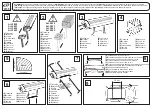
c03.fm
Planning a OpenScape Cordless IP System
Propagation Conditions for Radio Traffic
A31003-C1020-S100-03-7620, 12/2017
OpenScape Cordless IP V2, Service Documentation
37
Up to 100 m of the outdoor area can also be supplied through the windows.
For this purpose, the base station must be set up on an upper floor (> 3rd
floor, that is two levels above ground floor). Low-lying obstructions near the
base station, such as, vehicles or a garage (one or two cars) do not, in this
case, cause significant interference.
•
Reinforced concrete buildings and/or metal facades:
These have proven to be limiting factors. Penetration into the building is only
possible through windows (up to about 2 m into the building in the case of
standard size windows). The windows cannot be made from wire-reinforced
or metal-plated glass.
Wave conduction is possible in alleys between buildings as well as along
streets. This results in a larger radio area.
3.3.3 Indoor Areas in Buildings in Brick and Light
Construction Materials
•
Insertion loss values
In the case of walls of brick or light construction materials, insertion loss
values are relatively small so that even dividing walls of up to 30 m can be
penetrated.
•
Vertical attenuation
This is dependent on the ceiling type. In this case, reinforced concrete
ceilings that offer higher attenuation in particular compared to brick play a
decisive role in range evaluation.
These ceilings are dimensioned based on the purpose of the building, for
example,
–
single-family residence
–
apartment building
–
office building
–
theater
and so the insertion loss a
e
also differs accordingly; see Table 4.
















































